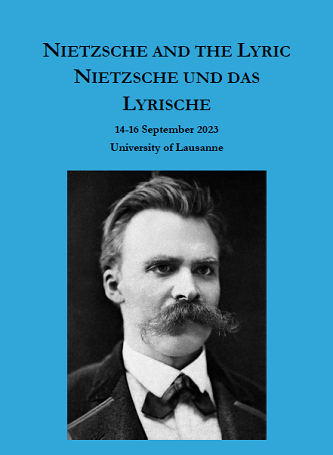‘Reading Zarathustra as a dramatization of the philosophy of the free spirit series’

International Conference of the Friedrich Nietzsche Society: Nietzsche and the Lyric / Nietzsche und das Lyrische
Panel presentation
University of Lausanne, Switzerland, 14-16 September 2023
Nietzsche’s Thus Spoke Zarathustra (1883-5) dramatizes the philosopher’s preceding free spirit series: Human, All Too Human (1878-80), Dawn (1881), and the original edition of The Gay Science (1882). This is to say, concepts from and the trajectory of the philosophy of the free spirit series are selected and interpreted through the images, the poetry, the lyrical milieu of Zarathustra.
Such a claim concerns an elision in the literature analysing the structure of Zarathustra. We know Zarathustra was written to explore eternal recurrence, both being introduced in the final two passages of the original edition of Nietzsche’s previous book (GS §341/§342). Zarathustra, declares Laurence Lampert, ‘exists as a vehicle for the thought of eternal return’ (1986: 4). Most scholars agree. So, why must we wait for Zarathustra III to encounter eternal recurrence? Why must we pass through Zarathustra I and Zarathustra II, encounter the overhuman and will to power before eternal recurrence? These questions are usually answered in one of two ways. On the one hand, the narrative structure emerges through the internal necessity of the story which explicates the growth of a teacher (Lampert). On the other hand, the three tales and a coda mirror the external necessity of the ancient Greek form of tragedy (Pippin and del Caro 2006: viii). All well and good, yet neither response tells us much. Why exactly the overhuman in ZI? Why exactly will to power in Z2?
I believe we can see Z1 as dramatizing the three books of Human, Z2 as dramatizing Dawn, and Z3 as dramatizing the original edition of Gay Science. To make this argument I draw upon two formulations from the literature concerning Nietzsche’s writing processes in the philosophical tradition. Parkes sees this in terms of concepts versus imagery (2005). Ansell Pearson and Large in terms of dramatization (2006). Accordingly, Zarathustra becomes a lens on the free spirit series, the image of the overhuman developing the concept of the free spirit as the major theme of Human; the image of will to power developing the concept of the vehemence of drives as the major theme of Dawn; and the image of eternal recurrence developing the concept of the comedy of existence as the major theme of the original edition of Gay Science.
If this seems somewhat fantastical, there is precedence for such considerations in Nietzsche studies. It is academic commonplace to say Nietzsche conceived both Beyond Good and Evil and On the Genealogy of Morality as commentaries upon Zarathustra (Horstmann 2001: xv; Parkes 2005: xi; Ansell-Pearson 2006: xvi; Löwith 1997: 19). Equally, if this assertion seems ‘old, familiar’, or even obvious, all the better (HHII: OM §200). Many, if not all, of the individual moments of the argument have indeed long been fashioned. Nonetheless, the argument has never been explicitly articulated – nor, moreover, the consequences drawn.